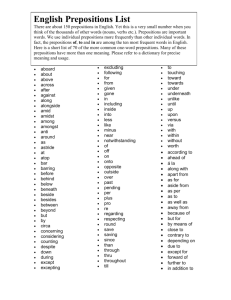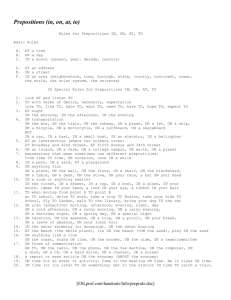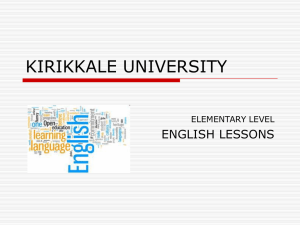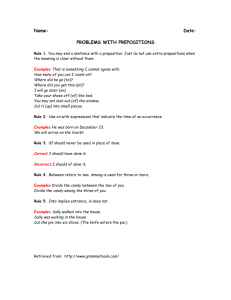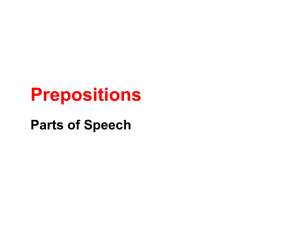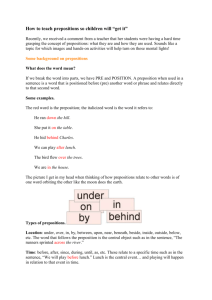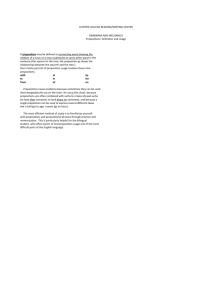PowerPoint
advertisement
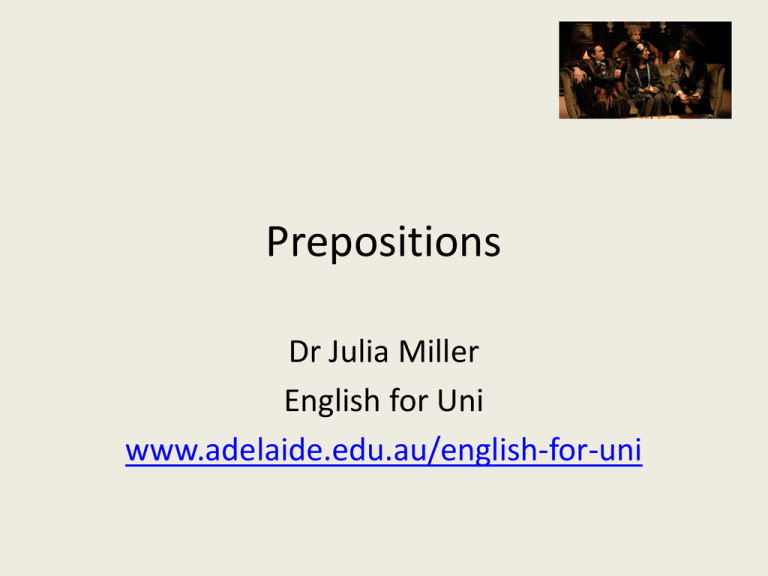
Prepositions Dr Julia Miller English for Uni www.adelaide.edu.au/english-for-uni The teaching materials in this PowerPoint presentation have been developed by Dr Julia Miller and are available on the English for Uni website. Funded by the Australian Government Office for Learning and Teaching. Prepositions are small words that show a relationship between one word and another word in English. They may not exist in another language, or they may be used differently. For example, we can say ‘The banana is in the bowl’ in this picture, even though it is not actually in the bowl but is sitting on top of the other fruit. We can say ‘in the bowl’ because we think of the banana as part of the whole collection of fruit, not as a separate item. In English, we often see things as concepts and do not examine them literally. That means we can use many prepositions in academic writing. For example, we can talk about an essay on chocolate. Perhaps we think of the essay as sitting on the topic of chocolate. We use on because it is the basis for something. Prepositions commonly used in academic writing about at for from in of on to with – around something or enclosing something – connected to a location – with a purpose or giving a reason – the origin of something – completely or partly enclosed by something – belonging to something or someone; contained in something – the basis for something – in a direction – connected to something and near something; using something The prepositions song Note the use of prepositions in academic English Please click on the photo above to go to the prepositions song on-in continuum How does this work in your first language? on on on on on on on on Clingy attachment Hanging over/ against Fixed attachment Point-topoint attachment Encircle with contact Support from below Marks on a surface Impaled/ spitted on Raindrops on window Picture on wall Handle on cupboard Apple on twig Ring on finger Cup on table Writing Apple on on paper stick Based on Bowerman and Pederson in Brala, M. M. (2002). Understanding language specificity: Causes and consequences. Psychology of Language and Communication. 6(2): 33-46. on-in continuum in in in in Pierces through Partial inclusion Still partial inclusion Inclusion Arrow in(to)/through apple Cigarette in mouth Apple in bowl Apple in box Based on Bowerman and Pederson in Brala, M. M. (2002). Understanding language specificity: Causes and consequences. Psychology of Language and Communication. 6(2): 33-46. With a Revolver in the Library What prepositions can you find in the story? Please click on the photo above to go to the With a Revolver in the Library video Prepositions exercise Please choose the correct preposition (in/of/on) for the sentences in this exercise. Here is a reminder of some uses of these prepositions: in – completely or partly enclosed by something of – belonging to something or someone; contained in something on – the basis for something 1. All the students will work ___ a collaborative environment. 2. They need to concentrate ___ their studies. 3. They will be placed ___ a range of community settings. Prepositions exercise continued 4. We examined the scientific basis ___ dental practice. 5. This degree appeals to students who are interested ___ working in the new fields and occupations created by digitisation. 6. The essay will be ___ a topic you have studied recently. 7. These are the cultural processes ___ globalisation. 8. Here is a simple analysis ___ algorithms. 9. The researchers are reliant ___ external funding. 10. This course provides the opportunity to focus ___ your major area of interest. Prepositions exercise continued 11. You will study this ___ a social context. 12. You will study the important causes ___ environmental change. 13. The course is ___ the boundary of advanced engineering and science. 14. This program offers a broad education in areas relevant to the study ___ human health. 15. Evolutionary Biology involves the study ___ information contained in living plants and animals. Answers to prepositions exercise 1. All the students will work in a collaborative environment. Details: The students will be surrounded by a collaborative atmosphere. 2. They need to concentrate on their studies. Details: The studies are the basis for their concentration. 3. They will be placed in a range of community settings. Details: They will be partly enclosed by the community settings. 4. We examined the scientific basis of dental practice. Details: The basis belongs to dental practice. 5. This degree appeals to students who are interested in working in the new fields and occupations created by digitisation. Details: The students are surrounded by their interest. 6. The essay will be on a topic you have studied recently. Details: The topic will be the basis for the essay. 7. These are the cultural processes of globalisation. Details: The processes belong to globalisation. 8. Here is a simple analysis of algorithms. Details: The algorithms belong to the analysis. 9. The researchers are reliant on external funding. Details: External funding is the basis for the researchers’ work. 10. This course provides the opportunity to focus on your major area of interest. Details: The major area of interest will be the basis for a student’s work in this course. 11. You will study this in a social context. Details: A social context will surround this study. 12. You will study the important causes of environmental change. Details: You will study the causes that belong to environmental change. 13. The course is on the boundary of advanced engineering and science. Details: The boundary of these two subjects is the basis for the course. 14. This program offers a broad education in areas relevant to the study of human health. Details: Human health is an area that belongs to the study. 15. Evolutionary Biology involves the study of information contained in living plants and animals. Details: The information belongs to the study.
